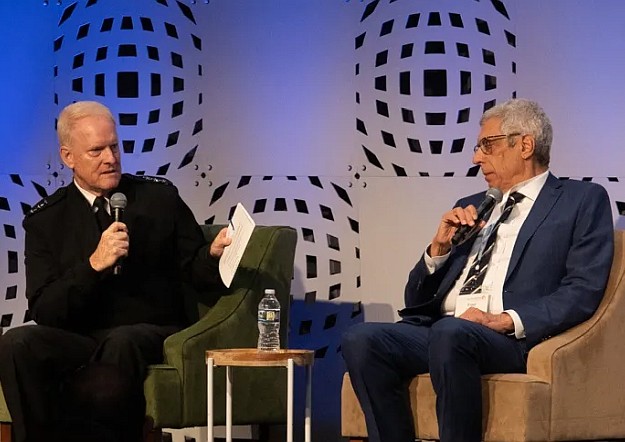
NGA Director Navy Vice Adm. Frank Whitworth talks with Saint Louis University President Fred Pestello at the Geo-Resolution conference. Image courtesy NGA.
Experts in geospatial information, public health, human migration and water, energy and food systems gathered at the Geo-Resolution conference at Saint Louis University in St. Louis, USA, on 28 September, to discuss the effects of climate change and how geospatial technology can be used to better understand and mitigate impacts.
The conference was co-hosted by the US National Geospatial-Intelligence Agency (NGA) and Saint Louis University. Approximately 450 people attended the conference in person; another approximately 350 people participated virtually from across the world.
At the conference, ESRI founder and CEO Jack Dangermond said humans are at a “profound moment” in history and that humans’ work to address climate change is “the most important work on the planet”.
“It’s going to take all of us — our best science, our best technology, our best design thinking, in order to figure this out,” Dangermond said.
NGA Director Navy Vice Adm. Frank Whitworth said that because climate change has been a topic of much debate, NGA has “a special responsibility” to ensure the data NGA is providing on climate change is accurate, to build trust with both the scientific community and the public as the United States begins to tackle the challenges that come with climate change.
Michael C. Morgan, assistant secretary of commerce for environmental observation and prediction and deputy administrator of the National Oceanic and Atmospheric Administration (NOAA), echoed the need for a “common understanding” of trust in climate change data.
Morgan also said NOAA’s ability to take effective action to address climate change depends on access to and plans based on geospatial and many other forms of data.
A “fusion of knowledge” created by all sorts of data — and powered by the experts that collect, distil and explain the data — can provide people with the understanding required to address complex issues related to climate change, said NGA’s Anthony Nguy-Robertson, a research and development scientist, during a panel on the impacts of freshwater access and supply due to climate change.
Andrew Hayden, director of the NGA College, also emphasized the value of a diverse workforce during a panel on developing geospatial talent.
“The world is complex,” he said. “NGA needs a diversity of thought to answer questions from different approaches and perspectives and “come up with new questions we haven’t anticipated yet.”
Hayden said exposure to GIS and other geospatial technology early in students’ academic journeys helps introduce students to geospatial career opportunities.
He also said curiosity is a common trait among the agency’s best geospatial analysts, and when a student can combine natural curiosity with geospatial exposure early on, it’s a winning recipe for a successful and rewarding career at NGA and for the agency’s success.
“Make it real to them,” he said. “Get them excited about learning about their world.”
Stay up to date by getting stories like this delivered to your inbox.
Sign up to receive our free weekly Spatial Source newsletter.







